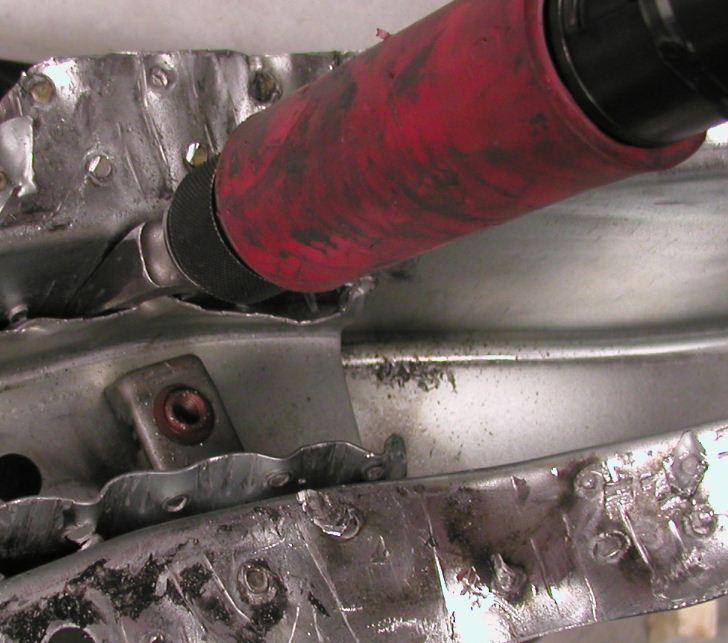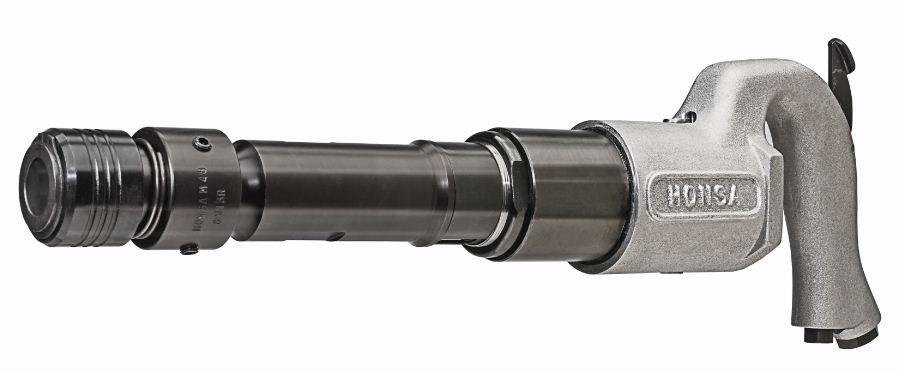- FMA
- The Fabricator
- FABTECH
- Canadian Metalworking
Gaining productivity in destructive weld testing
The fact that vibration-dampened, ergonomically designed tools reduce worker injuries, medical costs and associated downtime is indisputable.
- By Canadian Metalworking
- November 17, 2014

Within automotive "body shops" robotic spot welders assemble each unibody structure. Destructive impact testing using pneumatic chipping hammers reveals the hardness and shock-load capabilities of the welds.
In a twist on the old axiom of “work smarter, not harder,” advancements in ergonomically-designed power tools now enable line workers to “work softer, not harder.” These hard-hitting percussive tools can punch through tough boron steel while simultaneously softening the blow to the worker holding the gun.
Numerous studies have documented the effectiveness of vibration and impact absorbing systems in tools such as air hammers and chisels. Statistics compiled by the Washington State Department of Labor and Industries demonstrate the effectiveness through reductions in repetitive stress injuries range from 50-95 per cent, while improvements in productivity run from 50-75 per cent, with cost savings exceeding 25 per cent.
One area of manufacturing that could benefit from such gains is in destructive weld testing—especially in the production of motor vehicles, where weld quality assurance is not an option. Confirmation that robotically-performed welds meet design specifications helps ensure that the vehicle can withstand the expected loads and fatigue throughout its product lifetime.
“Ensuring quality starts in the body shop, with the weld robots doing their job and the weld destruct team doing their job,” says Phil Chabot, Vice President of Honsa Ergonomic Technologies, Inc., a Milan, IL-based manufacturer of ergonomically enhanced percussive and rotary tools that employ passive vibration-reduction technology.
“When I introduced our tools to the folks at the plants where the Taurus and Explorers are built, it was a game changer for Ford,” continues Chabot. “It used to take a team of four men, six hours to do a complete body teardown. We outfitted them with ergonomically-designed, vibration reducing tools and it dropped to just two guys doing the job in only 3 hours; a 75 per cent reduction in man hours.”
Destructive practices in auto manufacturing
Within the typical “body shop,” as many as 50 robotic spot welders assemble each unibody structure, performing scores of welds per vehicle. Average production volumes range from 1100-1200 vehicles per day. To ensure that all these units are built to specification, a complete tear down is usually required on one out of every 20,000 coming off the line.
The subject body travels to the teardown room where a team of operators use powerful pneumatic chipping hammers to conduct a 100 per cent tear down. This destructive impact testing reveals the hardness and shock-load capability of the weld by quantifying the energy required to break it apart.
The problem starts with the current trend toward boron and dual-phase steels which are extremely durable. But the downside is that such materials are very difficult rip apart with handheld tools. This is where both worker safety and production times suffer.
“At Ford Motor Company, we were faced with two significant challenges,” says Matt Laurain, a Weld Engineer for Ford. “First, we had to inspect larger welds that joined the thickest, strongest steels ever used in building an automobile. Second, we were tasked in obtaining ergonomic weld destruct tools that reduced vibration and injury to the operator.”
Percussive tools like air chisels transfer high levels of damaging vibration directly to the operator, leading to serious and devastating musculoskeletal and soft tissue disorders of the hands and arms.
“The sustained high levels of impact cause workers to take time off for medical visits,” Chabot points out. “This impacts the bottom line because worker’s comp’ costs rise along with medical insurance premiums.”
At the same time, productivity drops because the workers—in order to reduce the physical stress on their bodies—perform the teardown at a slower pace.
Post-war technology gives way to post-millennium
Until recently, many manufacturing facilities still used heavy, WWII era rivet guns, grinders and air hammers and chisels. Although this equipment was performing the targeted tasks, the impact of using heavy equipment was felt by operators as much as the metal materials they worked on.
The introduction of active, mechanical shock dampening systems about 20 years ago helped decrease worker injuries dramatically. However, these systems involve springs or air cylinders to reduce vibration. Thus, their effectiveness is limited to the calibration of the device, which changes over time; as well as the maintenance, or lack thereof, of the mechanism. Ultimately, these mechanical devices break. Since the majority of these tools are made overseas, in non-standard sizes, parts accessibility further slows production schedules.
Avoiding such shortcomings is a newer generation of impact absorption systems that are entirely passive. These designs incorporate non-mechanical damping in the form of polyurethane elastomers that require little or no maintenance.
“The best analogy would be that of a polyurethane motor mount that isolates the passengers from the engine vibrations,” explains Chabot. “You build it into the car, you don’t have to oil it or maintain it, and it lasts practically forever.”
Oftentimes these passive systems are used in conjunction with gooseneck handles on the tools that further act to reduce direct transmission of impact forces. So effective is this combination that lighter materials—such as aluminum, as opposed to cast steel—can be used for the body of the tools. This lighter weight also reduces worker fatigue.
In consideration of today’s tougher materials, many companies are working towards creating effective solutions. Honsa Tools, an Illinois-based focusing on ergonomic air tools, created a new class of weld destruct tools. These new modern impact hammers and chisels utilize improved tool valve designs with a superior barrel assembly material to cut through boron steel and associated welds. Since the worker is so well isolated from the sharp impact of the tool, stronger percussive forces can be used to speed the destructive process through any material.
Proven results
The fact that vibration-dampened, ergonomically designed tools reduce worker injuries, medical costs and associated downtime is indisputable.
As reported in a publication by the Washington State Department of Labor and Industries, a study by D.S. Chatterjee of workplace upper limb disorders on 695 automotive workers found that “upper extremity cumulative trauma disorders” dropped by 95 per cent in one year with the implementation of vibration-reduced power tools.
That same publication noted that Smolenski & Zamiska found that the intervention of redesigned tools in a group of auto workers reduced cumulative traumatic syndrome by more than 50 per cent over a two-year period.
Such improvements in worker health translate directly to increases in productivity. Reduced impact forces on the operator allow increased striking forces of the tool. Hence, more work can get accomplished in less time.
“If workers can bust through welds in half as much time without suffering any injuries, that halves the time the vehicle must spend in the weld destruct room,” notes Chabot. “The other upside is that the workers are exposed to half as much noise.”
The same Department of Labor and Industries publication also included a study of a tank disassembly facility that utilized low vibration impact wrenches with ergonomic features. The plant managed to cut the removal process almost 50 per cent. Another report noted one instance where reduced vibration hand tools cut the time to complete a military repair job from 15 days down to 11. Associated annual labor cost dropped from $72,000 to $52,800—which calculates to a 26.6 per cent annual savings.
The day may come when OSHA and state agencies mandate the use of reduced vibration power tools. In the meantime, both OEMs and tier suppliers can at least protect workers today while also protecting their profit margins.
For more information, visit www.honsatools.com.
subscribe now


Keep up to date with the latest news, events, and technology for all things metal from our pair of monthly magazines written specifically for Canadian manufacturers!
Start Your Free SubscriptionAbout the Author
- Industry Events
Automate 2024
- May 6 - 9, 2024
- Chicago, IL
ANCA Open House
- May 7 - 8, 2024
- Wixom, MI
17th annual Joint Open House
- May 8 - 9, 2024
- Oakville and Mississauga, ON Canada
MME Saskatoon
- May 28, 2024
- Saskatoon, SK Canada
CME's Health & Safety Symposium for Manufacturers
- May 29, 2024
- Mississauga, ON Canada





















